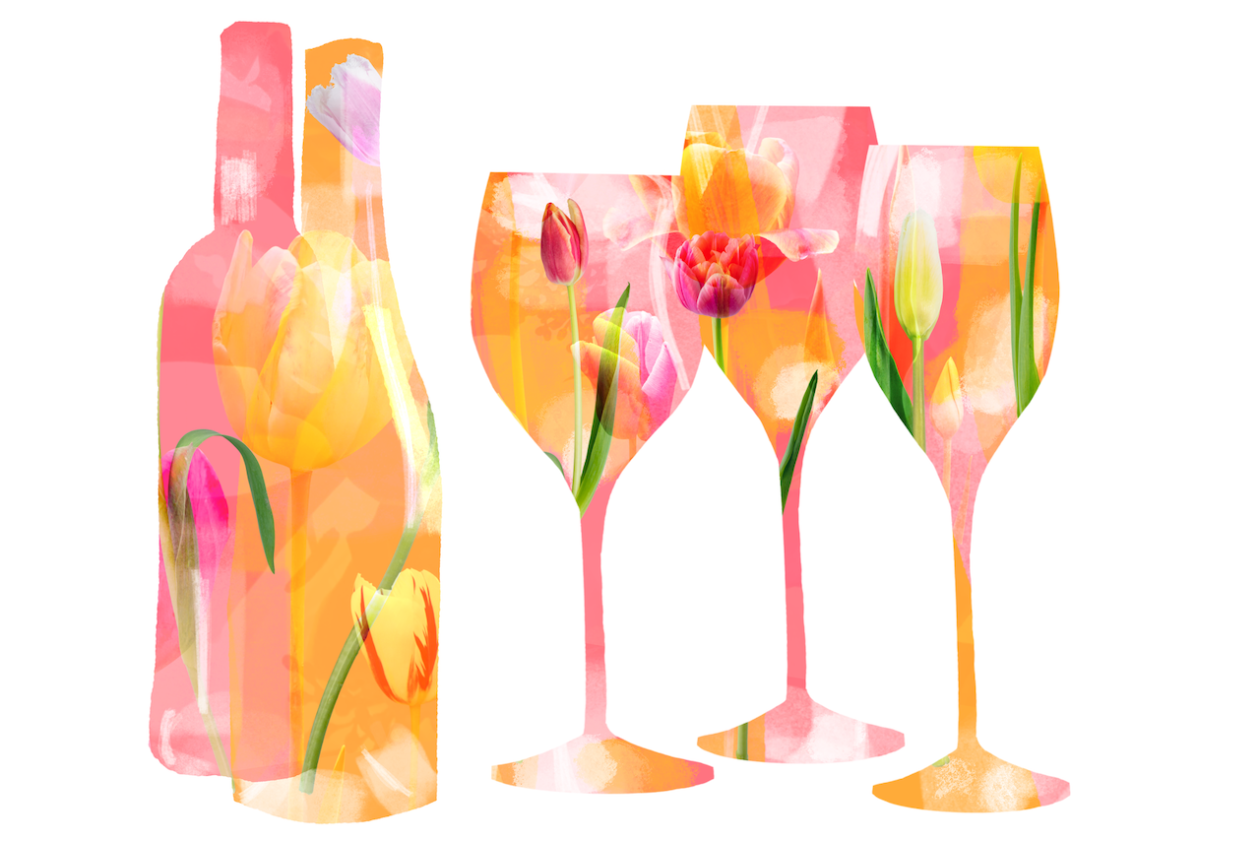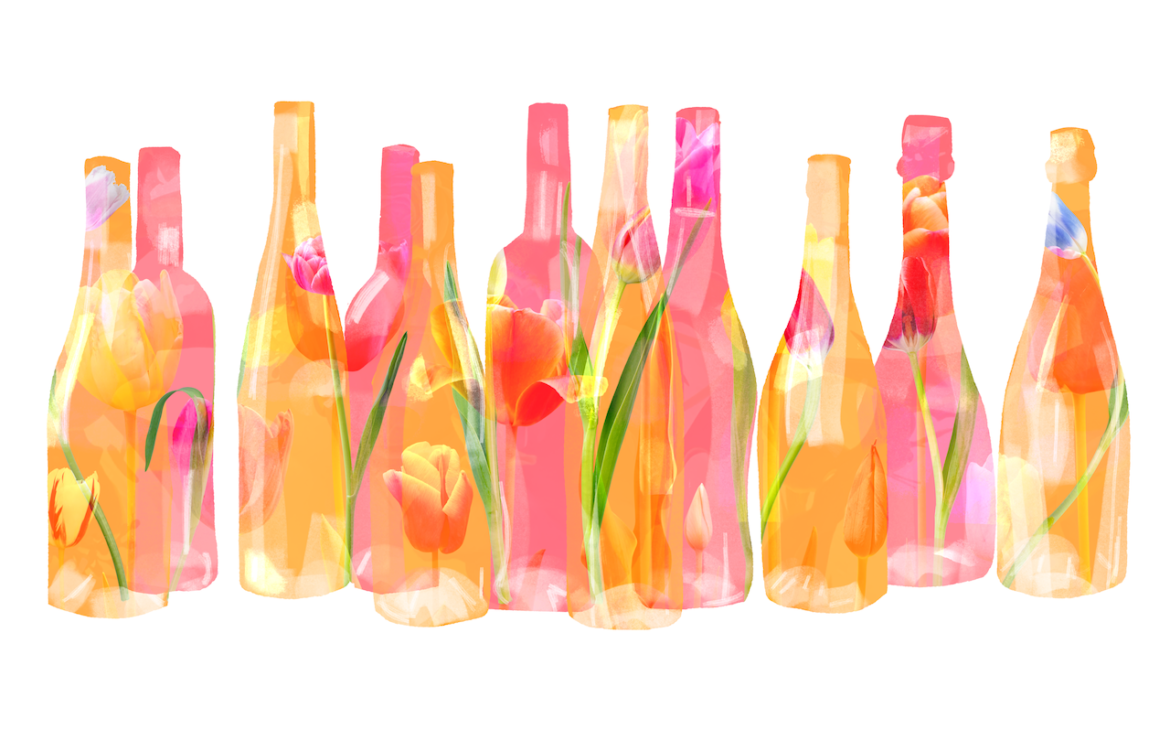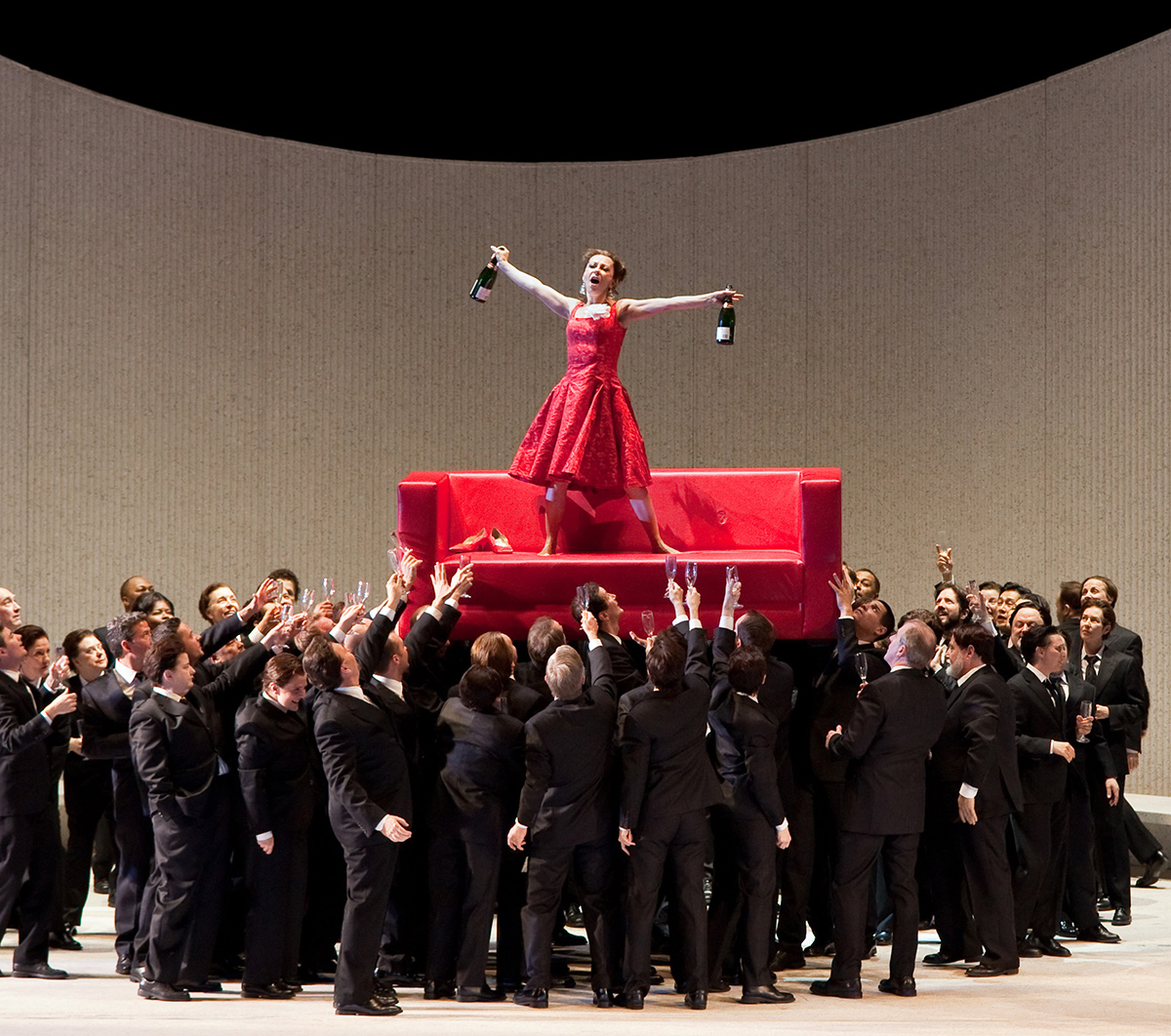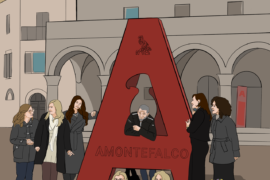Rosé, rosado, rosato, ramato, clairet, chiaretto, cerasuolo, schiller, blush, vin gris, oeil de perdrix, white [whatever], or just plain “pink.”
Nearly every region that makes red wine also makes rosé. It may be pale like onion skin or red like sunset. It may be still or sparkling. It may be fruity but is rarely truly sweet. It’s always made from red grapes, but sometimes blends in white.
It might not be a wine region’s principal output — Bordeaux, Rioja, Douro, and Tuscany, for example, make a lake of red but not much pink — but rosé earns place in heart and mind.
Rosé Wine Ascendant
For much of the 20th century, “rosé” signaled simplicity; think Mateus and Lancers, white Zin and pink Moscato. Those sweeter styles are still around, but the category is now deliciously diverse, with complex, gastronomic rosé available at all price points.
Recent global rosé production is way up. According to a 2023 report by the International Organization of Vine and Wine (OIV), rosé winemaking increased 25% since 2001, with France, Spain, and the U.S. accounting for two-thirds of global output. Meanwhile, red winemaking actually fell by 25%, and while white enjoyed an increase of 13%, that’s mostly due to sparkling (hello, Prosecco). Rosé wine now stands at 8% of production, up from 6% two decades ago.
The global thirst for rosé has been driven especially by France, Germany, the U.K., and the U.S., but consumption is also accelerating in South Africa, Russia, and Belgium. The style has been popularized in the media, which answered with books on rosé for consumers, new references and resources for professionals, and a multiplicity of articles in trade and lifestyle glossies. Not to mention all of us hashtagging our pink-washed pics online.
Rosé Winemaking 2.0
Along the way, the craftsmanship of rosé winemaking has demonstrably improved.
Historically, pale wines were often a byproduct of red winemaking, a program to use grapes or juice that wouldn’t otherwise make the cut. Liquid might be drawn off, or bled (saignée in French) from tanks at the start of red winemaking to concentrate the must, and the juice used to make a pinkish quaff. Fermentations were conducted in cement tanks or old wooden vats without temperature control, whatever was empty and available.
The approach allowed a winemaker to recover some costs, but the results could be unbalanced and insipid, lacking fruit, structure, freshness, elegance; lacking charm.
Rosé is now treated as a dedicated product rather than a winemaking afterthought. Winemakers, and indeed entire regions, have modified their processes from end to end. They grow fruit specifically destined for rosé, picking two or three weeks earlier than for a red wine program to preserve acidity. They macerate it briefly for a kiss of color (pale wines are highly popular), and press it gently to avoid astringency. Makers who continue to use the saignée method carefully manage contact time, oxygen exposure, and temperature to safeguard quality.
Technical winemakers may choose to add cultured yeast strains to coax specific floral or fruity notes, and yeast nutrients to ensure consistency. Most also ferment at colder temperatures to preserve aromatics. Rosé doesn’t usually spend long in tanks or bottles before release; most hit store shelves within eight or ten months of harvest.
Makers who take a hands-off approach (some call them “natural”) avoid additions of yeasts, yeast nutrients, and really much else. They’re also unlikely to block malolactic, even though it softens the wine’s desirable acidity, partly on principle and partly because the finished wines also become microbially more stable, requiring less sulfite. They also value the resulting textural and flavor elements.

No Rose-colored Glasses
When was the last time you saw rosé wine in anything but a clear glass bottle? Producers use colorless glass, called flint, to show off the wine’s lovely color and whet consumers’ thirst.
But flint glass begets a wine’s early demise. Light exposure, particularly from UV-A and blue portions of the spectrum, is swiftly damaging to the aromas of white, rosé, and sparkling wines. The phenomenon, known as light strike, has been well characterized — and it doesn’t even require direct sunlight. Recent research showed that just a week on a supermarket shelf flattened a wine’s aromatics and eliminated varietal character. Longer exposures can render a wine vegetal, sulfurous, and stinky.
The problem is widespread. On a recent Wine Blast episode with Susie Barrie MW and Peter Richards MW, rosé expert Liz Gabay MW estimated that 30% of rosé samples she receives are compromised, while Panagiotis Arapitsas PhD reported a figure of 80% from a recent wine competition.
The consequences are ruinous not only for individual bottles but for the industry as a whole, given that consumers might assume, after tasting many dull and characterless examples, that rosé is not for them. Fortunately the solution is simple: Jettison flint glass in favor of amber, which blocks 90% of harmful wavelengths. Consumers are already accustomed to buying reds, whites, and sparklers in colored bottles; they can get used to pinks that way. Just imagine your rosé wearing sunglasses.
Busting Myths About Rosé Wine
Despite the present day proliferation of rosé, many myths persist.
Myth: Rosé is pink
Reality: Well, just look at it. It’s more orange than pink, more Ken than Barbie. The bluish pigment in grape skins, anthocyanin, isn’t particularly stable at the low pH of rosé wine. Rosé made from ultra dark grapes like Syrah seem more violet when young, but even those will shift toward yellow over time.
Myth: Quality rosé is pale pink
Reality: Rosé comes in a range of hues and shades, and color does not indicate quality.
Myth: Rosé color indicates flavor
Reality: Color has no bearing on flavor. Lighter wines can be shy and delicate or robust and fruity. Darker wines can be mouth-filling and textural or high-toned and elegant. You can’t tell by looking. You have to taste it.
Myth: Rosé is for girls
Reality: Ha, ha. Move along.
Myth: Rosé is sweet
Reality: Rosé is dry. Or most fine rosé is dry. Exceptions include historical styles like Rosé d’Anjou and rosé sparkling wine, which, like all sparkling wine, may have a shot of sugar to balance the acidity.
Myth: Rosé is crisp
Reality: It usually is, especially when the fruit is harvested young and vinified in stainless steel with temperature control. But rosé can be fermented and aged in oak, or put through malolactic (ML), making it feel rounder and more expansive.
Myth: Rosé is not age-worthy
Reality: Generally you do want the most recent vintage, but some styles, for example Bandol, Tavel, and wines made in an oxidative style, with barrel fermentation, barrel aging, or both, can acquire depth with a few years in the cellar.
Myth: Rosé is cheap
Reality: You get what you pay for. Five bucks gets an industrial wine, but fifteen-plus gets a thoughtful wine from an interesting grape, maker, and region. Some ultra-premium rosé costs well over $50, and at this writing a bottle of Les Horées Bourgogne Rosé Bonheur would set you back $360. But it’s hard to pay more than $25, and mostly you don’t need to.
Myth: Rosé is simplistic
Reality: Rosé is fine wine. Many producers are now dedicating themselves to producing complex, balanced, premium wines worth discovering.
TASTING ROSÉ WINE
Right now the 2023 Northern hemisphere rosé are hitting store shelves. There’s a deliciously bewildering array of colors, flavors, temperaments, and nationalities. Below is an assortment of rosé wines I recommend, many I’ve previously reviewed. (You can also peruse my full rosé reviews archive.) I’ve chosen to exclude Provençal wines to encourage you to free range; those wines are lovely but ubiquitous, and there’s so much more to discover.
Domaine de la Bastide Blanche Rosé Bandol (France)
Château Maris Rosé de Nymphe Emue Minervois (France)
Yves Cuilleron Sybel Syrah Rosé Collines Rhodaniennes (France)
Château Thivin Rosé Beaujolais-Villages (France) — my review
Mas de Daumas Gassac Guilhem Rosé Pays d’Hérault (France)
Jean-Baptiste Adam Crémant d’Alsace Brut Rosé (France) — my review
Lanson Brut Rosé Champagne (France) — my review
François Chidaine Rosé Touraine (France) — my review
Sanzay Rosé Saumur (France) — my review
Bodegas Bermajo Listán Negro Rosado Lanzarote (Spain) — my review
Raúl Pérez Los Arrotos del Pendón Rosado Léon (Spain)
Azores Wine Company Rosé Vulcanico Pico Island (Portugal) — my review
Conterno Nervi Il Rosato Gattinara (Italy)
Le Vigne di Alice Spumante Brut Rosé Osé Veneto (Italy)
Erpacrife Nebbiolo Spumante Método Classico Langhe (Italy) — my review
Maccario Lavignone Rosato Piemonte (Italy)
Ciavolich Fosso Cancelli Cerasuolo d’Abruzzo (Italy) — my review
Gorgo Chiaretto Bardolino (Italy) — my review
Kir-Yianni Xinomavro Rosé L’Esprit du Lac Vieilles Vignes Amyndeon (Greece) — my review
Tegernseerhof Mittlebach Zweigelt Rosé Niederösterreich (Austria) — my review
Seehof Pinot Noir Rosé Rheinhessen (Germany)
Schäfer Dry Rosé Rheinhessen (Germany) — my review
Kobal Wine Estate Pét Nat Rosé Bajta Podravje (Slovenia)
Joseph-Jibril Pinot Noir Rosé Russian River Valley Sonoma County (USA) — my review
Jolie-Laide Valdigué Rosé Rosewood Vineyard Mendocino County (USA) — my review
Onward Pinot Noir Rosé Pétillant Naturel Hawkeye Ranch Redwood Valley (USA) — my review
Heitz Cellars Grignolino Rosé Napa Valley (USA) — my review
La Garagista Ci Confonde Rosé Pétillant Naturel Vermont (USA) — my review
Gallica Estate Rosé St. Helena Napa Valley (USA) — my review
Birichino Vin Gris California (USA) — my review
Arnot Roberts Rosé Lake County (USA)
Unti Rosé Dry Creek Valley (USA)
Many thanks to Vinography for recommending this article to their readers.





An excellent read Meg. I especially appreciate your reporting on light strike. I’ve underestimated its impact. And you’ve reminded me of an old favorite- François Chidaine Rosé Touraine. Haven’t purchased since I moved away from a wine shop that carried it (plus I’m buying more local these days) Cheers!
Martin, thanks so much for reading and your kind comment. Light strike is incredibly damaging, really an existential threat to the whole category. I hope things shift soon. And glad to offer a reminder of that Chidaine — so good!
Such a great article! All of this was great mythbusting, but my favorite…
“Myth: Rosé is for girls
Reality: Ha, ha. Move along.”
Here is to rosé in all it’s many forms! (Perhaps enjoyed in the company of a wise cat 🐈)
Thanks, Robin!
The light strike data is pretty dramatic – and frightening, with its potential to keep consumers from having optimal Rosé experiences.
Agreed.